Occupational environment monitoring at the factory producing notebooks
99,000 ₫
Note: The above price is calculated for one sample, the price may fluctuate depending on the area of the environment to be monitored and the movement of the market. For more accurate price support, please refer to the quotation table or contact directly with our consulting staff.
Environmental monitoring of notebook manufacturing factories is a session of collecting, analyzing, and evaluating factors in the workplace that may be harmful to the health of workers.
Table of Contents
Toggle1. Overview of Notebook Production Factory
a. What is a notebook production factory?
A production factory for notebooks is a facility specialized in manufacturing and processing various types of notebooks. Notebooks are diverse products, including exercise books, journals, notepads, school books, and other similar products used for studying, note-taking, recording information, and expressing creativity.
Notebook production factories usually have production processes such as cutting, assembling, pressing, heating, printing, binding covers, and finishing products. The production stages include preparing raw materials, processing and assembling components, printing and designing content, and finally packaging and binding the products.
The machinery and equipment commonly used in notebook production factories include paper cutting machines, presses, printing machines, binding machines, and other equipment to carry out production stages. The technology and production processes in these factories are often automated and controlled by equipment to ensure accuracy and efficiency during production.

b. Production stages in notebook production factories
The production stages in a notebook production factory may include:
- Raw material preparation: This stage involves preparing necessary materials for notebook production, including paper, cardboard, printing ink, adhesive, etc.
- Printing: After preparing materials, the printing stage begins. Content, images, and other information are printed onto paper using printing machines, including offset and digital printers.
- Paper processing and cutting: Printed pages are processed and cut into desired sizes and shapes using specialized paper cutting machines, ensuring uniformity and accuracy.
- Pressing and heating: Pressing and heating stages are carried out to combine pages together or with cardboard covers, using pressing and heating machines.
- Binding: Pages are bound into notebooks using various binding technologies, such as softcover binding, hardcover binding, or tray-based binding.
- Finishing: This stage includes quality control, trimming excess edges, creating book edges, marking, and labeling products. It is the final step to complete the notebooks before packaging.
- Packaging: Finally, notebooks are packaged into bags or boxes, depending on product requirements and regulations.

c. Machinery used in notebook production factories
In notebook production factories, various machines are used to carry out production stages. Some common machines include:
- Offset printing machine: Used to print notebook pages with high quality and accuracy.
- Digital printing machine: Used for small quantities or personalized notebooks. It offers fast and flexible printing.
- Paper cutting machine: Used to cut printed pages into desired sizes and shapes.
- Binding machine: Used to press pages or cardboard covers together, forming the notebook structure.
- Heat machine: Used to combine pages or pages with cardboard using temperature and pressure.
- Book binding machine: Various binding machines are used, including softcover, hardcover, large format, and automatic binding machines, to bind pages and covers into notebooks.
- Trimming machine: Used to trim excess edges of notebooks, ensuring clean and uniform edges.
- Packaging machine: Used to pack notebooks into bags or boxes.

d. Occupational diseases that workers in notebook factories may face
Workers in notebook production factories may suffer from certain occupational diseases related to their work. Some common occupational diseases include:
- Nervous system issues: Workers may be affected by noise from machinery, leading to hearing problems and nervous system stress.
- Skin diseases: Exposure to chemicals can cause skin irritation and allergies, including ink, adhesives, and chemicals used in paper processing.
- Respiratory diseases: Workers may inhale paper dust, ink fumes, chemicals, and other irritants, causing issues such as rhinitis, pharyngitis, pneumonia, and allergies.
- Musculoskeletal and spinal problems: Poor posture or heavy lifting can lead to stress and injuries in the spine, muscles, and joints.
- Vision problems: Prolonged exposure to bright lights from printers, scanners, and other equipment may cause eye strain and vision issues.
- Occupational accidents: Working with machinery and tools poses risks of cuts, burns, or other injuries.
To reduce the risk of occupational diseases, safety measures should be applied, including personal protective equipment, proper ventilation, adherence to safety procedures, and staff training on preventive measures.

e. Common types of notebooks on the market
There are many common types of notebooks, classified based on purpose and features. Some popular types include:
- Notepads: General-purpose notebooks used for taking notes, journaling, or daily work. They come in hardcover or softcover and various sizes and designs.
- Study notebooks: Used for education and studying, with blank sections for exercises, subject notes, or group work.
- Creative notebooks: Designed to encourage creativity and thinking, containing exercises, puzzles, activities, and blank spaces for writing, drawing, or idea generation.
- Planner and time management notebooks: Help users plan, manage time, and record goals, task lists, and schedules.
- Art notebooks: Used for recording ideas, drawing, note-taking, and creating artworks, usually with high-quality pages and durable covers.
- Sticky notes notebooks: Contain multiple self-adhesive sheets that can stick to different surfaces, commonly used for quick notes, reminders, or office tasks.
2. Overview of occupational environment monitoring services
a. What is occupational environment monitoring at notebook production factories?
Occupational environment monitoring (or occupational environment measurement) at notebook production factories involves collecting, evaluating, and analyzing measured indicators of workplace environmental factors to take timely measures, minimize environmental hazards to workers’ health, and prevent occupational diseases. It is a mandatory regulation for notebook production factories.
Monitoring plays a crucial role in caring for, protecting, and enhancing workers’ health because the main resource of a business, directly generating profit, is its workforce. Workers regularly exposed to excessive occupational hazards may suffer health impacts and develop occupational diseases.
REGISTER FOR OCCUPATIONAL ENVIRONMENT MONITORING SERVICE
b. Nam Viet’s occupational environment monitoring program
Nam Viet’s occupational environment monitoring program is researched by engineers in occupational safety and environmental protection. Aiming to ensure worker health and safety, the program uses modern measurement methods to monitor air, water, microclimate, physical, and dust factors in the workplace. This program is crucial for ensuring a safe working environment and protecting workers’ health.
Additionally, the program plays an important role in researching and developing new solutions to improve workplace environmental quality. With the dedication and professionalism of its monitoring experts, Nam Viet’s exclusive monitoring program is a breakthrough in occupational safety management and environmental protection in Vietnam.

c. Standardization in workplace measurement procedures
Standardization in Nam Viet’s workplace measurement procedures is crucial for ensuring accurate and reliable results. The program follows standards and recognized procedures of the Ho Chi Minh City Department of Health. This ensures that collected data can be reliably used for workplace evaluation and making decisions to improve worker health and workplace safety.
These standardized procedures also ensure that measurements are performed by highly skilled monitoring experts with many years of experience, allowing managers and specialists to trust results from An Toàn Nam Việt and make accurate, valuable decisions in protecting worker health and the environment.
By applying standardization, Nam Viet demonstrates its commitment to ensuring a safe workplace, protecting workers’ health, and contributing to improving occupational safety management and environmental protection in Vietnam.
d. Report on occupational environment monitoring results at notebook production factories
Monitoring results are prepared according to Form No. 04, Appendix III, issued with Decree 44/2016/ND-CP and made in 2 copies: one copy sent to the workplace that signed the monitoring contract, and one copy kept at the monitoring organization.
The retention period for occupational environment monitoring results follows legal regulations and is indefinite.

e. Frequency of occupational environment monitoring according to law
According to Clause 2 of Article 18 of the Occupational Safety and Health Law 84/2015/QH13, employers must organize occupational environment monitoring to assess hazardous factors at least once a year.
f. Deadline for submitting occupational environment monitoring reports according to law
The deadline for submitting reports is before December 31 each year. Enterprises in production facilities must submit monitoring results to the local Department of Health where the enterprise has its headquarters and where employees are working.
When there are changes in technology, production processes, or upgrades that may introduce new hazards to workers’ health, enterprises must update occupational hygiene records regarding factors requiring monitoring.
g. Regulations on penalties for employers violating occupational environment monitoring
According to Article 27 of Decree No. 12/2022/ND-CP dated January 17, 2022, regulating administrative penalties in labor, social insurance, and Vietnamese workers working abroad under contract:
- Clause 2: A fine of VND 2,000,000 – 5,000,000 for employers who do not publicly disclose monitoring results and hazard management at workplaces immediately after monitoring results are available.
- Clause 3: A fine of VND 20,000,000 – 40,000,000 for employers who fail to carry out occupational environment monitoring to control impacts on workers’ health according to law.
- Clause 4: A fine of VND 40,000,000 – 60,000,000 for employers who collude with monitoring organizations to commit fraud in monitoring activities, but not reaching criminal liability.
3. Harmful Environmental Factors for Workers in Notebook Production Factories
There are several environmental factors that may harm workers in notebook production factories. Here are some of the main factors:
- Airborne dust and particles: The notebook production process can generate dust and small particles from cutting, shredding paper, and other production processes. Inhaling dust and particles may cause respiratory irritation, pneumonia, and other health problems.
- Chemicals: During notebook production, additives, printing inks, adhesives, and other chemical compounds may be used. Exposure to these substances can cause skin irritation, eye inflammation, nervous system issues, or other health problems.
- Noise: Machinery and equipment in notebook production factories can produce high levels of noise. Continuous noise exposure can damage hearing, cause stress, insomnia, and negatively impact overall health.
- Lighting: Notebook production factories often use bright lighting to enhance production efficiency. Long-term exposure to strong light can cause eye strain, visual fatigue, and vision problems.
- Emissions and air pollution: Production processes in the factory may generate emissions and air pollution. Exposure to pollutants can harm the respiratory system and cause health issues.
- Ergonomics: Some production stages may require workers to work in uncomfortable postures or perform tasks involving vibration or physical strain. This can lead to back pain, neck pain, shoulder pain, and other musculoskeletal problems.
REGISTER FOR WORKPLACE ENVIRONMENT MONITORING SERVICE
4. Measures to Improve the Working Environment in Notebook Production Factories
To improve the working environment in notebook production factories and protect workers’ health, the following measures can be applied:
- Ensure proper ventilation and fan systems: Provide effective ventilation to reduce humidity, chemical odors, and dust in the air. Use exhaust fans to remove polluted air.
- Ensure dust control systems: Use effective dust control systems such as dust extraction and filters to minimize dust presence in the working environment.
- Training and safety guidance: Provide safety training and instructions to staff on how to use and handle additives, chemicals, and machinery safely. Ensure workers know about personal protective measures such as wearing masks, gloves, goggles, and appropriate protective clothing.
- Noise control: Apply noise control measures such as using noise-reducing equipment, isolating noisy machinery, or providing ear protection for workers.
- Lighting control: Ensure appropriate lighting levels in work areas to avoid eye strain. Use suitable lighting and protect workers’ eyes with goggles or shields.
- Use non-toxic materials: Use materials and chemicals that are non-toxic or minimally toxic to reduce exposure to harmful substances.
- Ergonomics: Improve workplace design to ensure comfortable working postures, support, and reduce physical strain for workers. Adjust desk heights, seating, and provide support tools like back cushions and armrests to reduce pressure and musculoskeletal stress.
- Regularly conduct workplace environment monitoring in factories, collect and analyze harmful factors affecting workers, and adjust measures to reduce risks and prevent occupational diseases.
5. Benefits of Regular Monitoring of Notebook Production Factories
An Toan Nam Viet provides excellent benefits for businesses using workplace environment monitoring services according to Decree 44/2016/ND – CP on managing and controlling harmful factors in the working environment affecting employees.
- Businesses can proactively control harmful factors in workshops or factories.
- Receive consultation and recommendations on measures to reduce harmful factors and improve the working environment quality.
- Indirectly protect human resources, a key factor in the company’s development process.
- Reduce the impact of occupational diseases on human health, thereby minimizing future treatment costs.
- Improve workers’ health, leading to better product quality and maintained production output.
- Ensure compliance with labor safety laws and avoid legal risks.
- Enhance credibility and professionalism in all aspects, elevating the company’s brand.
Nam Viet’s environmental monitoring service is a solution to reduce occupational disease risks, contributing to a clean and high-quality working environment.

6. National Workplace Environment Monitoring Center
Workplace Environment Monitoring Center of Nam Viet is a professional unit for supervising and measuring the quality of workplace environments across all provinces in Vietnam. With a team of experienced monitoring specialists, the center uses modern measuring equipment to ensure accuracy and reliability.
In addition to providing monitoring services, the center supports clients in planning, managing, and following up on workplace environmental issues. Following the motto “customer-centric,” the center prioritizes client satisfaction, meets all customer needs, and commits to providing the best solutions for businesses.
REGISTER FOR WORKPLACE ENVIRONMENT MONITORING SERVICE
With investments in technology, equipment, and human resources, Nam Viet’s monitoring center has become one of the reputable units in workplace environment monitoring in Ho Chi Minh City, with the following objectives:
- We always value brand reputation and the quality of our service products.
- We provide clients with the best and most suitable solutions possible.
- Along with a team of experienced Masters and Engineers, committed to protecting the environment and benefiting businesses.
- By choosing Nam Viet Environmental Monitoring, your company will receive professional service from experts in the field and enjoy the best cost advantages.
The workplace environment monitoring process at Nam Viet includes the following basic steps:
- Before conducting monitoring, we ensure that all machinery and equipment are calibrated and adjusted according to legal regulations.
- Carry out the workplace environment monitoring process as committed to the Department of Health.
- Report workplace environment monitoring results honestly to the employer.
- If the monitoring results do not ensure safety for workers, Nam Viet will support corrective solutions and the workplace will implement:
- Implement measures to improve working conditions to minimize the impact of harmful factors and prevent occupational diseases.
- Organize health checks to detect occupational diseases and related illnesses early for employees in unsafe working conditions.
- Provide in-kind compensation to workers according to labor law regulations.

7. Workplace Environment Monitoring Price List
To help businesses conduct workplace environment monitoring professionally and effectively, Nam Viet provides clients with a comprehensive and reasonably priced monitoring service price list.
- Our price list provides detailed information about the costs of the monitoring services we offer, including travel, measurement, analysis, and reporting. Clients can be fully assured of the accuracy and reliability of the monitoring reports we provide.
- We commit to offering competitive and reasonable prices in the market and are always ready to consult and answer any questions about monitoring services promptly and professionally.
- With Nam Viet’s monitoring price list, clients can easily choose service packages that fit their needs. We commit to delivering the highest satisfaction with professional service quality.
No comments yet

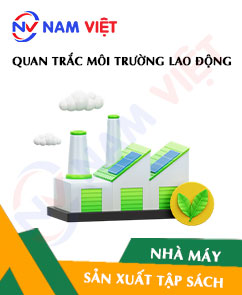
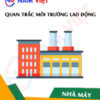
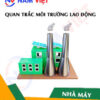



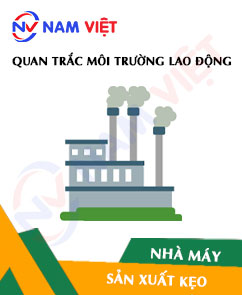
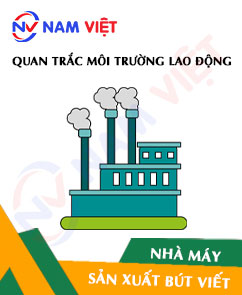
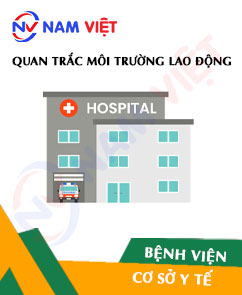
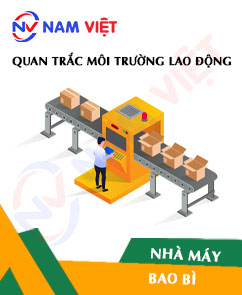

Review Occupational environment monitoring at the factory producing notebooks
There are no reviews yet.